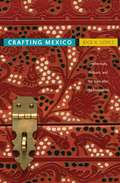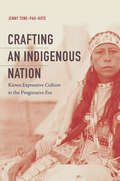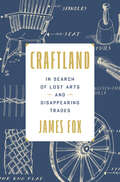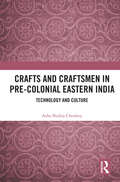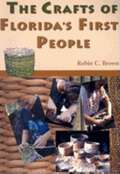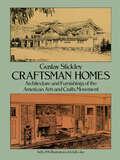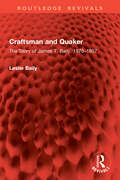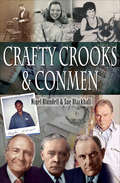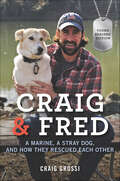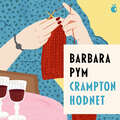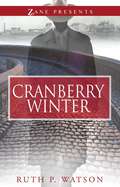- Table View
- List View
Crafting Mexico: Intellectuals, Artisans, and the State after the Revolution
by Rick A. LópezAfter Mexico's revolution of 1910-1920, intellectuals sought to forge a unified cultural nation out of the country's diverse populace. Their efforts resulted in an "ethnicized" interpretation of Mexicanness that intentionally incorporated elements of folk and indigenous culture. In this rich history, Rick A. Lpez explains how thinkers and artists, including the anthropologist Manuel Gamio, the composer Carlos Chvez, the educator Moiss Senz, the painter Diego Rivera, and many less-known figures, formulated and promoted a notion of nationhood in which previously denigrated vernacular arts--dance, music, and handicrafts such as textiles, basketry, ceramics, wooden toys, and ritual masks--came to be seen as symbolic of Mexico's modernity and national distinctiveness. Lpez examines how the nationalist project intersected with transnational intellectual and artistic currents, as well as how it was adapted in rural communities. He provides an in-depth account of artisanal practices in the village of Olinal, located in the mountainous southern state of Guerrero. Since the 1920s, Olinal has been renowned for its lacquered boxes and gourds, which have been considered to be among the "most Mexican" of the nation's arts. Crafting Mexico illuminates the role of cultural politics and visual production in Mexico's transformation from a regionally and culturally fragmented country into a modern nation-state with an inclusive and compelling national identity.
Crafting Policies to End Poverty in Latin America
by Ana Lorena De La OThis book provides a theory and evidence to explain the initial decision of governments to adopt a conditional cash transfer program (the most prominent type of antipoverty program currently in operation in Latin America), and whether such programs are insulated from political manipulations or not. Ana Lorena De La O shows that whether presidents limit their own discretion or not has consequences for the survival of policies, their manipulation, and how effective they are in improving the lives of the poor. This book is the first of its kind to present evidence from all Latin American CCTs.
Crafting Preservation Criteria: The National Register of Historic Places and American Historic Preservation
by John H. Sprinkle, Jr.In 1966, American historic preservation was transformed by the passage of the National Historic Preservation Act, which created a National Register of Historic Places. Now comprising more than 1.4 million historic properties across the country, the National Register is the official federal list of places in the United States thought to be worthy of preservation. One of the fundamental principles of the National Register is that every property is evaluated according to a standard set of criteria that provide the framework for understanding why a property is significant in American history. The origins of these criteria are important because they provide the threshold for consideration by a broad range of federal preservation programs, from planning for continued adaptive use, to eligibility for grants, and inclusion in heritage tourism and educational programs. Crafting Preservation Criteria sets out these preservation criteria for students, explaining how they got added to the equation, and elucidating the test cases that allowed for their use. From artworks to churches, from 'the fifty year rule' to 'the historic scene', students will learn how places have been historically evaluated to be placed on the National Register, and how the criteria evolved over time.
Crafting Turkish National Identity, 1919-1927: A Rhetorical Approach (Routledge Studies in Modern History)
by Aysel MorinExamining Mustafa Kemal Atatürk’s Büyük Nutuk (The Great Public Address), this book identifies the five founding political myths of Turkey: the First Duty, the Internal Enemy, the Encirclement, the Ancestor, and Modernity. Offering a comprehensive rhetorical analysis of Nutuk in its entirety, the book reveals how Atatürk crafted these myths, traces their discursive roots back to the Orkhon Inscriptions, epic tales, and ancient stories of Turkish culture, and critiques their long-term effects on Turkish political culture. In so doing, it advances the argument that these myths have become permanent fixtures of Turkish political discourse since the establishment of Turkey and have been used by both supporters and detractors of Atatürk. Providing examples of how past and present leaders, including Recep Tayyip Erdoğan, a vocal critic of Atatürk, have deployed these myths in their discourses, the book offers an entirely new way to read and understand Turkish political culture and contributes to the heated debate on Kemalism by responding to the need to go back to the original sources – his own speeches and statements – to understand him. Contributing to emerging discourse-based approaches, this book is ideal for scholars and students of Turkish Studies, History, Nationalism Studies, Political Science, Rhetorical Studies, and International Studies.
Crafting a Republic for the World: Scientific, Geographic, and Historiographic Inventions of Colombia
by Lina Del CastilloIn the wake of independence, Spanish American leaders perceived the colonial past as looming over their present. Crafting a Republic for the World examines how the vibrant postcolonial public sphere in Colombia invented narratives of the Spanish “colonial legacy.” Those supposed legacies included a lack of effective geographic knowledge, blockages to a circulatory political economy, existing patterns of land tenure, entrenched inequalities, and ignorance among popular sectors. At times collaboratively, and at times combatively, Colombian leaders tackled these “colonial” legacies to forge a republic in a hostile world of monarchies and empires. The highly partisan, yet uniformly republican public sphere crafted a vision of a virtuous nation that, unlike the United States, had already abolished slavery and included Indians as citizens. By the mid-nineteenth century, as suffrage expanded to all males over twenty-one, Colombian elites nevertheless tinkered with territorial divisions and devised new constitutions to manage the alleged “colonial legacy” affecting the minds of popular voters. The book explores how the struggle to be at the vanguard of radical republican equality fomented innovative contributions to social sciences, including geography, cartography, political ethnography, constitutional science, history, and the calculation of equity through land reform. Paradoxically, these efforts created a kind of legal pluralism reminiscent of the Spanish monarchy during the “colonial” period.
Crafting an Indigenous Nation: Kiowa Expressive Culture in the Progressive Era
by Jenny Tone-Pah-HoteIn this in-depth interdisciplinary study, Jenny Tone-Pah-Hote reveals how Kiowa people drew on the tribe's rich history of expressive culture to assert its identity at a time of profound challenge. Examining traditional forms such as beadwork, metalwork, painting, and dance, Tone-Pah-Hote argues that their creation and exchange were as significant to the expression of Indigenous identity and sovereignty as formal political engagement and policymaking. These cultural forms, she argues, were sites of contestation as well as affirmation, as Kiowa people used them to confront external pressures, express national identity, and wrestle with changing gender roles and representations. Combatting a tendency to view Indigenous cultural production primarily in terms of resistance to settler-colonialism, Tone-Pah-Hote expands existing work on Kiowa culture by focusing on acts of creation and material objects that mattered as much for the nation's internal and familial relationships as for relations with those outside the tribe. In the end, she finds that during a time of political struggle and cultural dislocation at the turn of the twentieth century, the community's performative and expressive acts had much to do with the persistence, survival, and adaptation of the Kiowa nation.
Crafting the Movement: Identity Entrepreneurs in the Swedish Trade Union Movement, 1920–1940
by Jenny JanssonCrafting the Movement presents an explanation of why the Swedish working class so unanimously adopted reformism during the interwar period. Jenny Jansson discusses the precarious time for the labor movement after the Russian Revolution in 1917 that sparked a trend towards radicalization among labor organizations and communist organizations throughout Europe and caused an identity crisis in class organizations. She reveals that the leadership of the Trade Union Confederation (LO) was well aware of the identity problems that the left-wing factions had created for the reformist unions.Crafting the Movement explains how this led labor movement leaders towards a re-formulation of the notion of the worker by constructing an organizational identity that downplayed class struggle and embraced discipline, peaceful solutions to labor market problems, and cooperation with the employers. As Jansson shows, study activities arranged by the Workers' Educational Association became the main tool of the Trade Union Confederation's identity policy in the 1920s and 1930s and its successful outcome paved the way for the well-known "Swedish Model."Thanks to generous funding from Uppsala University, the ebook editions of this book are available as Open Access volumes from Cornell Open (cornellopen.org) and other Open Access repositories.
Crafting the Witch: Gendering Magic in Medieval and Early Modern England (Studies in Medieval History and Culture)
by Heidi BreuerThis book analyzes the gendered transformation of magical figures occurring in Arthurian romance in England from the twelfth to the sixteenth centuries. In the earlier texts, magic is predominantly a masculine pursuit, garnering its user prestige and power, but in the later texts, magic becomes a primarily feminine activity, one that marks its user as wicked and heretical. This project explores both the literary and the social motivations for this transformation, seeking an answer to the question, 'why did the witch become wicked?' Heidi Breuer traverses both the medieval and early modern periods and considers the way in which the representation of literary witches interacted with the culture at large, ultimately arguing that a series of economic crises in the fourteenth century created a labour shortage met by women. As women moved into the previously male-dominated economy, literary backlash came in the form of the witch, and social backlash followed soon after in the form of Renaissance witch-hunting. The witch figure serves a similar function in modern American culture because late-industrial capitalism challenges gender conventions in similar ways as the economic crises of the medieval period.
Craftland: In Search of Lost Arts and Disappearing Trades
by James FoxAn &“impassioned and inspiring account of the extraordinary men and women still doing traditional artisanal work&” (The Sunday Times) in the face of massive technological industrialization—by renowned Cambridge art historian Dr. James Fox.&“Shimmers with love for a dwindling world of meticulous, patient labour . . . deftly written and well researched.&”—The GuardianDuring an age of mass manufacturing, fast fashion, synthetic materials and the unsustainable practice of companies valuing quantity over quality, a return to tradition, connection, and simplicity is essential.Art historian and award-winning broadcaster Dr. James Fox explores the rapidly fading crafts and artisanal traditions of the world—such as coopering, basket-weaving, wheelwrighting, metalwork, and blacksmithing—that have shaped so much of our history through their alchemy of the hand-made human touch and generational wisdom.Fox explains the history of craftsmanship in Britain, taking readers across the lands and communities that originated there, teaching them about the practices, traditions, and people at their heart. From coopers to thatchers, basket makers to bellfounders and dry wall builders, Fox tours Britain, once the workshop of the world, in search of its lost and disappearing craft traditions and the artisans trying to keep them alive including, a rush weaver who has managed to rebuild a sustainable business with her baskets and other wares, a bell foundry that uses the same practices it used in the nineteenth century, and dry wallers, building walls one piece of stone at a time that could last two centuries. Part travelogue and part historical record, Craftland is a profoundly intimate meditation on our human cultural heritage, exploring what we lose as these traditions fade from view in the race of progress, and what we stand to gain if we bring them back.
Crafts and Craftsmen in Pre-colonial Eastern India: Technology and Culture
by Asha Shukla ChoubeyThis book presents a comprehensive socio-cultural history of crafts and crafts persons in pre-colonial Eastern India. It focuses on the technology of crafts as being integral to the traditional lives of the crafts persons and explores their cultural and social world. It offers an in-depth analysis of the complexities of craft technologies in the three sectors of cotton textile, sericulture and silk textile and mining and metallurgy in the regions of Bihar and Jharkhand in Eastern India in the seventeenth and eighteenth centuries. Apart from technology, the book discusses a range of socio-economic themes including craft production systems; marketing and financing patterns; impact of contact with the world market; craft persons’ identities in terms of caste affiliations and group divisions; negotiations for upward caste mobility; contestations and dissent of lower castes; power and social stratification; functioning of caste panchayats; gender division of craft labour; myths, beliefs and religiosity attributed to craft usages; social and ritual traditions; and contemporary craft traditions. Rich in archival and diverse sources, including oral traditions, paintings, and findings from extensive field visits and interactions with crafts persons, this book will be an essential read for scholars and researchers of crafts, medieval Indian history, social history, sociology and social anthropology, economic history, cultural history, science and technology studies, and South Asian studies. It will also interest government and non-governmental organisations, textile historians, craft and design specialists, contemporary craft industrial sector, and museums.
Crafts of Florida's First People
by Robin C. BrownThere were people living all over Florida for twelve thousand years before Columbus got here. Before hardware stores and shopping malls, these people managed to get food, make clothing, and cook their meals. In The Crafts of Florida's First People, Robin Brown asks, How did they do it? And to answer his question, he actually learns to do things the way they did. Using materials that you can find in Florida today, you can learn with him how to throw spears and darts, make pottery, weave cloth, mix paint, build traps, and even how to start a fire without matches—just the way Florida's first people did it for thousands of years. Each chapter has easy-to-follow, fully illustrated directions. Even if you dont have the natural supplies available in your area, the book includes suggestions for alternative materials so you can still learn their crafts. As you work, you will experience some of the daily life of the ancient peoples of Florida. You will find out not only how to make a spear, but what its construction tells us about how the first people hunted and what animals they ate. The last true Florida native died 200 years ago, but you can help keep their culture alive.
Craftsman Bungalows: 59 Homes from "The Craftsman" (Dover Architecture)
by Gustav StickleyGustav Stickley (1858-1942) was one of the leading lights of the Arts and Crafts movement in America, an organized effort which sought beauty in simple organic design. His magazine, The Craftsman, was a major forum for the movement's ideas and concepts - ideas which today are enjoying a renaissance in the design community. The present publication features 36 articles that appeared in The Craftsman between 1903 and 1916. Included are graphic descriptions of 59 "bungalows" (Most of which were actually spacious, year-round homes), floor plans for 35 dwellings, and many sketches or photographs of houses in landscaped settings. Characterized by its functional simplicity and integrated with the outdoor environment, the Craftsman home was typically composed of locally obtainable materials. A few of the most modest homes - according to the magazine - could even be constructed by persons with a minimum of masonry and carpentry experience. Interiors reflected the simple lines of the exteriors and generally included an ample fireplace (often of fieldstone construction), fireside benches, built-in bookcases and sideboards, plus walls, floors, and ceiling beams decorated - preferably - in colors that would harmonize with the structure's natural surroundings. This inexpensive volume of selected Craftsman articles provides collectors of Americana with a fascinating glimpse of an influential and thoroughly American style of architectural design and construction. Craftsman Bungalows will be welcomed as a primary source of information and ideas by architects, students, and historians of architecture, preservationists, restorers - anyone interested in the Arts and Crafts movement in America. Dover (1988) republication of 36 articles from The Craftsman magazine, 1903-1916.
Craftsman Bungalows: Designs from the Pacific Northwest (Dover Architecture Ser.)
by Yoho MerrittFrom the late nineteenth century to the early 1920s, the Arts and Crafts Movement spread with great popularity across America. With origins in Britain, the Craftsman style was a reaction against the excesses of the Victorian era. Craftsman bungalows were distinguished by their charming simplicity, cozy style, and storybook appeal. The name was derived from a popular magazine called The Craftsman, published by renowned furniture designer Gustav Stickley who sold plans for these homes designed for "beauty, convenience, and comfort." This fascinating reprint of a rare architectural catalog is filled with photos of actual completed bungalows from the era, built prior to 1919. A mix of Spanish tile, stucco exteriors, wraparound porches, overhanging gables, handcrafted stone, and woodwork added up to many a homeowner's dream. Geared to the climate of the northern and eastern regions, each bungalow is an authentic Craftsman design and features a photo, description, floor plan, and original costs. A fascinating showcase of primary American architecture, Craftsman Bungalows is an indispensable resource for architects, builders, historians, and illustrators.
Craftsman Farms
by Heather E. StivisonCraftsman Farms was the country estate of the father of the American Arts and Crafts movement, Gustav Stickley. Though Stickley is credited with creating hundreds of home designs, this property contains the only home he designed and built for his own use. His rustic log house was built upon a rolling hillside surrounded by lawns, stone walls, and working farmland. In September 1917,the property was purchased by Sylvia and George Farny, who loved it dearly and passed it on to their descendants. Portions of the 650 acres were sold, but the core remained intact until the 1980s, when it was threatened by condominium development. Community activists launched a "Save the Farms" campaign, which led to the Township of Parsippany-Troy Hills purchasing Craftsman Farms through eminent domain. Today, it is a busy historic house museum operated by the nonprofit Craftsman Farms Foundation. Craftsman Farms showcases the significant design legacy Gustav Stickley created as well as the architectural and landscape history of this New Jersey National Historic Landmark.
Craftsman Homes: Architecture and Furnishings of the American Arts and Crafts Movement
by Gustav Stickley296 architectural drawings, floor plans, and photographs illustrate 40 different kinds of "Mission-style" homes from The Craftsman (1901-16), voice of American style of simplicity and organic harmony. Thorough coverage of Craftsman idea in text and picture, now collector's item.
Craftsman and Quaker: The Story of James T. Baily, 1876–1957 (Routledge Revivals)
by Leslie BailyFirst published in 1959, Craftsman and Quaker is the story of one man’s life told against a background of the profound social changes of eighty years. Leslie Baily, well-known for his ‘Scrapbook’ and other historical radio programmes, extracted material from his father’s diaries and letters and presented it as a very human story through this book.James T. Baily began life in humble circumstances in Sheffield, where his own father was a carpenter and joiner. Through many changes of circumstances, J.T.B. became a teacher of crafts and in due course was recognized as one of Britain’s leading authorities on crafts-teaching in schools, serving on a deputation to America to study methods over there. His methods and principles were far ahead of his time. During the First World War, J.T.B. organized work for the idle prisoners in internment camps and did similar work in Ireland during the civil war there. He also worked in Germany on famine relief. In the Second War, he had some remarkable experiences among evacuees and refugees.A former secretary of the National Union of Manual Training Teachers and a Fellow of the College of Handicraft, he was crafts master of the famous Quaker school at Ackworth, a ‘Mr. Chips’ of real life.
Craftsmen of the Army: The Story of the Royal Electrical and Mechanical Engineers, 1993–2015
by Prince PhilipThe Corps of Royal Electrical and Mechanical Engineers (REME) provides the Armys integral repair and recovery capability. Its soldiers are deployed at the front line and have to be capable of switching instantly from a technical role to fighting alongside those they support, as their many awards for gallantry demonstrate.This, the third volume of REMEs distinguished history covers the period from post-Cold War drawdown to the end of UK combat operations in Afghanistan, during which time REME was continuously involved in operations. The narrative knits together personal accounts of front line experiences with an explanation the political and military background, with a particular focus on equipment support issues.It explains how REME operates and deals with broader issues related to the procurement and support of equipment, and the changing organizations delivering these vital services, within which members of REME have frequently played key enabling roles.
Crafty Crooks & Conmen
by Nigel Blundell Sue BlackhallFrom Clifford Irving and his Howard Hughes hoax to the great imposter Frank &“Catch Me if You Can&” Abagnale—a fascinating history of the art of the con. They&’re shrewd, cunning, devious—and charmingly trustworthy. While the criminal exploits of these tricksters, frauds, and swindlers can&’t be condoned, it&’s near-impossible not to be awed by their audacity and ingenuity. Take Victor Lustig, the &“Bouncing Czech&” who sold the Eiffel Tower—twice; John Stonehouse, a philandering politician who faked his own death to escape his sins; the impotence cure of the bizarre Dr. John Brinkley who transplanted goat testicles on gullible men; embarrassingly successful Goldman Sachs embezzler Joyti De-Laurey; or Robert Hendy-Freegard, a car salesman and serial seducer who convinced scores of women he was an MI5 agent. Here, too, are the exploits of a &“friend of the stars&” who infiltrated a royal castle; a fake Scots &“laird&” who operated from the heart of Scotland Yard; evangelists who fell from grace; and other pilferers, parasites, artful dodgers, charming bastards, femme fatales, big fat liars, and grand masters of dishonorable mention.
Craig & Fred: A Marine, a Stray Dog, and How They Rescued Each Other
by Craig GrossiA heartwarming story of a stray dog and a U.S. Marine who met under the unlikeliest circumstances in Afghanistan—and who changed each other’s lives forever. As part of an elite team of Marines, Craig Grossi was sent on his most dangerous assignment to the Sangin District of Afghanistan. He expected to face harsh conditions and violence from Taliban fighters. What he didn’t expect was to meet a stray dog, with a big goofy head and little legs—a dog all on his own, filthy and covered in bugs, in a bomb-ridden district, but who carried himself with confidence. And even though the Marines have a rule against approaching strays, Craig couldn’t help but offer some food and a pat—and was shocked when the dog wagged his tail. From that moment on, they were inseparable; whether out on missions or back at the base, the dog named Fred went along. When the time came for Craig to leave Afghanistan, he knew that Fred had to leave with him no matter what. And as Craig tried to get acclimated to civilian life, Fred was there for him.This book tells the inspiring story of two friends who ultimately rescued each other, and the stubborn positivity and love that continue to shape their world.
Cramm This Book: So You Know WTF Is Going On in the World Today
by Olivia SeltzerFrom the founder of The Cramm, a news outlet by and for the incredible Gen Z activists who are already shaping our global future (really!), this book is a dive into the history that's made the world what it is today.You can take a stand for justice. You can raise your voice to make a difference. You can find your way to make a mark and change the world. But first—you need to know what the actual F is going on in it. Today&’s world can feel like a seriously confusing mess. Headlines and newscasters and posts are coming at us from all sides, each talking about the latest issues and injustices, and everyone with their own opinion on how to solve the problems of the day. It&’s enough to make anyone&’s mind melt. Right? Enter: Cramm This Book, your one-stop-shop for the scoop behind the scoop of the day. This is the read you need to understand everything from how the conflicts in the Middle East got going to where Black Lives Matter and Me Too actually began to what the full deal is with all of the wildfires and hurricanes we see each year. Important topics to read more about? We think so too. Dip in for more on the wars, the movements, the disasters, and more—and get to know WTF is really going on. Are you ready to take to the streets and take on the world? Then Cramm This Book and get going. The future is ours. What are you waiting for? Praise for Cramm This Book: * "Insightful, balanced, and nuanced [with a] final message [that] is a direct challenge to readers: now that you understand these problems, are you going to do something about them?" --Booklist, *STARRED REVIEW* * "This highly informative text explains to Gen Zers that they not only have a voice, but the power to use it . . . a timely, useful, and much-needed title." --School Library Connection, *STARRED REVIEW*"Seltzer&’s authorial tone is easygoing, self-aware, honest, and inviting while delivering crucial and sensitive information . . . This is an ideal work for readers seeking a starting point for world knowledge and societal activism." --Kirkus Reviews "A super helpful resource for social studies classes and catching up on social, economic, and political events." --School Library Journal
Crampton Hodnet (Virago Modern Classics #310)
by Barbara PymINTRODUCED BY LOUIS DE BERNIERES'I'm a huge fan of Barbara Pym' RICHARD OSMAN'I'd sooner read a new Barbara Pym than a new Jane Austen' PHILIP LARKINFormidable Miss Doggett fills her life by giving tea parties for young academics and acting as watchdog for the morals of North Oxford. Anthea, her great-niece, is in love with a dashing undergraduate with political ambitions. Of this, Miss Doggett thoroughly approves. However, Anthea's father, an Oxford don, is carrying on in the most unseemly fashion with a student - they have been spotted together at the British museum! But the only liaison Miss Doggett isn't aware of is taking place under her very own roof: the lodger has proposed to her paid companion Miss Morrow. She wouldn't approve of that at all.'Brilliant, hilarious and so very, very English' DAILY MAIL'My favourite writer . . . I pick up her books with joy' JILLY COOPER
Cranberry Lake and Wanakena (Postcard History Series)
by Susan Thomas SmebyIn the northwest corner of the Adirondack Park lie Cranberry Lake and the village of Wanakena. This remote area was the last-settled part of New York State; from the mid-1800s to the early 1900s, its name evoked the very essence of wilderness. Initially, sportsmen, naturalists, and artists flocked to the area. By 1900, summer tourism was booming. The logging industry followed, to harvest the virgin timber; after that, the state purchased the mostly cleared lands. Today, seventy-five percent of the lake's shoreline is state owned, and the Five Ponds Wilderness, south of Wanakena, is one of the largest and wildest areas in the Adirondacks.
Cranberry Township (Images of America)
by Veronica Rice Guerriero Kate Guerriero BenzIt is hard to imagine a version of Cranberry Township that was comprised of lush forests, gently rolling hills, and cascading waves of open fields. For the settlers who arrived here in the late 1700s, it was an Eden of abundant opportunity--tranquility that proved irresistible. They purchased hundreds of acres, built self-sustaining farms, and planted their roots. These pioneers had names like Graham, Garvin, Duncan, Meeder, Rowan, and Goehring, and many of their descendants still remain. While its name pays homage to the marshy bogs that produced succulent cranberries, its heritage is rooted in humble beginnings that remained largely untouched for centuries. Only with the dawn of an expanding highway system beginning in the 1950s did Cranberry Township begin its rapid transformation from farm community to suburban hot spot.
Cranberry Winter: A Novel
by Ruth P. WatsonRomance, suspense, and murder are at the center of this evocative sequel to the popular Blackberry Days of Summer and An Elderberry Fall.Nothing seems to change for Carrie Parker. Even as she attempts to move on, her life is still haunted by reminders of the late Herman Camm, the beady-eyed, small man who forever changed the life of her family. His twin, Kindred, is in town and he is the spitting image of his brother, yet everyone feels he is the opposite of his irresponsible, womanizing twin. He is accepted immediately but Carrie is afraid. Is he actually the dead Herman come back to life? Simon, her husband, thinks she is losing her mind, as he is too busy chasing his dream of being a major Colored League baseball player, but now he is spending less time on the road. Carrie suspects he knows about her intimate friendship with Adam Murphy, who is spending his spare time in Petersburg, pursuing Carrie as if she is available. There's more than meets the eye with Kindred, and Carrie's mother is willing to do whatever she can to help Carrie determine if he really is someone new. Soon, all the suspicions are satisfied when Kindred's true identity is revealed. But with a twist no one is expecting, the town is now reeling with an unsolved murder on its hands. Another tantalizing whodunit by Ruth P. Watson, Cranberry Winter is a provocative novel that will keep you guessing until the very end.
Cranbury (Images of America #Vol. 1)
by Peggy S. Brennan Frank J. Brennan Jr.Few New Jersey towns have retained as much nineteenth-century charm as Cranbury. Set in agriculturally rich Middlesex County, Cranbury is known for its shuttered white-clapboard houses, lovely shaded streets, picket fences, and tranquil lake. First settled in 1697, Cranbury came of age more than one hundred years later when it developed into a bustling center with a gristmill, a sawmill, tanneries, blacksmith shops, and other business enterprises typical of small-town America. These images are fascinating: most of them have never before been published, and many of them were donated from family albums and collections. The recollections of many living residents have been included as well, and the stories, anecdotes, and memories breathe life into the images of a by-gone era. The result is a remarkable visual history, both informative and entertaining, that serves to preserve and celebrate Cranbury's proud heritage. Cranbury is a journey into the past that will thrill resident and visitor, young and old alike.
